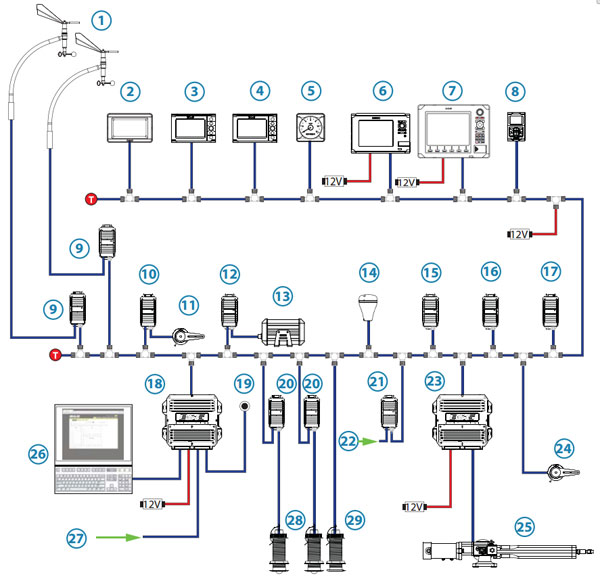
This network bus is an installed and operational network cable running the length of your boat, already connected to a power supply and properly terminated. Technically, any physical cable properly installed and used to transfer network information is a "network bus" but in our documentation we use this term to refer to the standard manufacturer installation appearing in new boats. However, if you have a sonar display unit (with a working transducer) connected to the NMEA bus it will share the digital depth with every other display unit on the network. Every sonar display unit requires its own transducer to draw charts.
#Nmea 2000 connectors lowrance full
The full sonar chart reading from a transducer takes too much bandwidth for a NMEA 2000 network which means sonar charts cannot be shared. You probably noticed there is no transducer mentioned in that list or anywhere else in this document. Other capabilities include the ability to share the amount of fuel remaining in your tanks, detailed engine information such as oil pressure and fuel efficiency and much more. Of course location, speed and temperature are not the only kinds of information that can be shared. Every display unit, gauge or sensor attached to the network communicates with all the others. That is the advantage of a NMEA 2000 network. NMEA 2000 network with three sonar or sonar-GPS combo display units, each receiving position information from the LGC-2000, temperature information from temp sensors at two different locations and fuel use information from a fuel flow sensor. The network design would look like the one in the following diagram. All three display units attached to the bus would have access to all of the sensor information from every accessory attached to the network. The network could share all of this information with a sonar-GPS combo display unit mounted in the dash, a smaller sonar-only display unit at the stern and another up on the bow by your trolling motor. Such a network could display the temperature readings from two different sensors (one at the water surface and another in your live well) as well as the GPS signal from an LGC-2000 and even the reading from a fuel-flow sensor attached to your fuel line. The other end of the scale is a network bus (described in the following segment) built into your boat with nodes at intervals allowing you to connect several GPS or sonar display units, temperature or water speed sensors, digital gauges or any other NMEA 2000 device. This is a very limited application of the term "network." NMEA 2000 network passing GPS signal information along the network (that is, the extension cables) to the GPS display unit. The connectors and cables that came with your LGC-2000 actually function as a dedicated If you have a Lowrance display unit with an LGC-2000 GPS module installed then you have a NMEA 2000 network. You can even view engine diagnostics and fuel level on digital gauges or display units located anywhere on your boat.

If you pick up a phone in your living room you can hear someone talking into the phone in the bedroom.Ī NMEA 2000 network is a way to let more than one display unit "listen in" on the GPS antenna's conversation or to let more than one sonar display unit overhear the messages being sent by a temperature sensor. Think of this as a computer network or the phone wiring in your house. "LowranceNET" is the NMEA 2000 networking system developed by Lowrance Electronics. When we talk about the NMEA 2000 network we are talking about the communications link between two or more devices that transfer NMEA 2000 information. All of them will help you understand what we are saying.

Some of these are technical terms, some of them are names taken from the NMEA 2000 standard and some of them are our own names developed for clarity. There are several key phrases you will need to know before we can explain how the NMEA 2000 system works.
#Nmea 2000 connectors lowrance how to
It also will explain how to use this network to connect your Lowrance and LEI products and provide some tips on configuring and using the operational network. This instruction sheet outlines the basics of what it takes to create a NMEA 2000 network. To help you get the most out of this technology Lowrance has introduced a line of products that can communicate over a NMEA 2000 network. This is an industry standard developed by the National Marine Electronics Association(NMEA).

NMEA 2000 is a communication bus network specifically designed for boats.


 0 kommentar(er)
0 kommentar(er)
